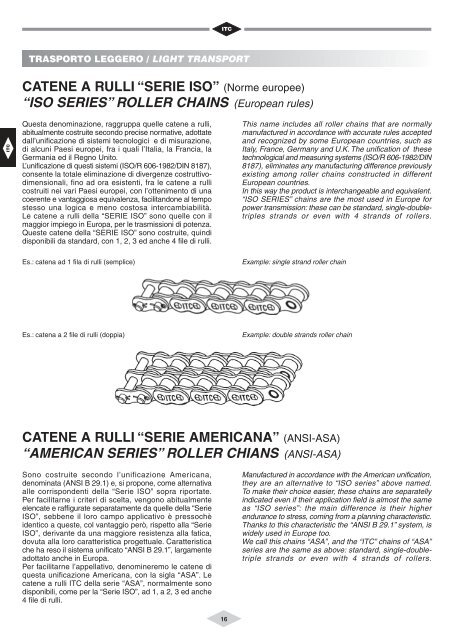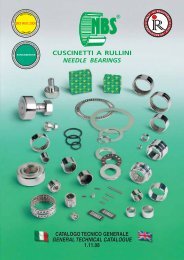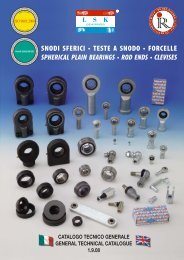ITC
ITC
ITC
You also want an ePaper? Increase the reach of your titles
YUMPU automatically turns print PDFs into web optimized ePapers that Google loves.
<strong>ITC</strong><br />
TRASPORTO LEGGERO / LIGHT TRANSPORT<br />
CATENE A RULLI “SERIE ISO” (Norme europee)<br />
“ISO SERIES” ROLLER CHAINS (European rules)<br />
Questa denominazione, raggruppa quelle catene a rulli,<br />
abitualmente costruite secondo precise normative, adottate<br />
dall’unificazione di sistemi tecnologici e di misurazione,<br />
di alcuni Paesi europei, fra i quali l’Italia, la Francia, la<br />
Germania ed il Regno Unito.<br />
L’unificazione di questi sistemi (ISO/R 606-1982/DIN 8187),<br />
consente la totale eliminazione di divergenze costruttivodimensionali,<br />
fino ad ora esistenti, fra le catene a rulli<br />
costruiti nei vari Paesi europei, con l’ottenimento di una<br />
coerente e vantaggiosa equivalenza, facilitandone al tempo<br />
stesso una logica e meno costosa intercambiabilità.<br />
Le catene a rulli della “SERIE ISO” sono quelle con il<br />
maggior impiego in Europa, per le trasmissioni di potenza.<br />
Queste catene della “SERIE ISO” sono costruite, quindi<br />
disponibili da standard, con 1, 2, 3 ed anche 4 file di rulli.<br />
Es.: catena ad 1 fila di rulli (semplice)<br />
CATENE A RULLI “SERIE AMERICANA” (ANSI-ASA)<br />
“AMERICAN SERIES” ROLLER CHIANS (ANSI-ASA)<br />
Sono costruite secondo l’unificazione Americana,<br />
denominata (ANSI B 29.1) e, si propone, come alternativa<br />
alle corrispondenti della “Serie ISO” sopra riportate.<br />
Per facilitarne i criteri di scelta, vengono abitualmente<br />
elencate e raffigurate separatamente da quelle della “Serie<br />
ISO”, sebbene il loro campo applicativo è pressochè<br />
identico a queste, col vantaggio però, rispetto alla “Serie<br />
ISO”, derivante da una maggiore resistenza alla fatica,<br />
dovuta alla loro caratteristica progettuale. Caratteristica<br />
che ha reso il sistema unificato “ANSI B 29.1”, largamente<br />
adottato anche in Europa.<br />
Per facilitarne l’appellativo, denomineremo le catene di<br />
questa unificazione Americana, con la sigla “ASA”. Le<br />
catene a rulli <strong>ITC</strong> della serie “ASA”, normalmente sono<br />
disponibili, come per la “Serie ISO”, ad 1, a 2, 3 ed anche<br />
4 file di rulli.<br />
16<br />
Example: single strand roller chain<br />
Es.: catena a 2 file di rulli (doppia) Example: double strands roller chain<br />
<strong>ITC</strong><br />
This name includes all roller chains that are normally<br />
manufactured in accordance with accurate rules accepted<br />
and recognized by some European countries, such as<br />
Italy, France, Germany and U.K. The unification of these<br />
technological and measuring systems (ISO/R 606-1982/DIN<br />
8187), eliminates any manufacturing difference previously<br />
existing among roller chains constructed in different<br />
European countries.<br />
In this way the product is interchangeable and equivalent.<br />
“ISO SERIES” chains are the most used in Europe for<br />
power transmission: these can be standard, single-doubletriples<br />
strands or even with 4 strands of rollers.<br />
Manufactured in accordance with the American unification,<br />
they are an alternative to “ISO series” above named.<br />
To make their choice easier, these chains are separatelly<br />
indicated even if their application field is almost the same<br />
as “ISO series”: the main difference is their higher<br />
endurance to stress, coming from a planning characteristic.<br />
Thanks to this characteristic the “ANSI B 29.1” system, is<br />
widely used in Europe too.<br />
We call this chains “ASA”, and the “<strong>ITC</strong>” chains of “ASA”<br />
series are the same as above: standard, single-doubletriple<br />
strands or even with 4 strands of rollers.





